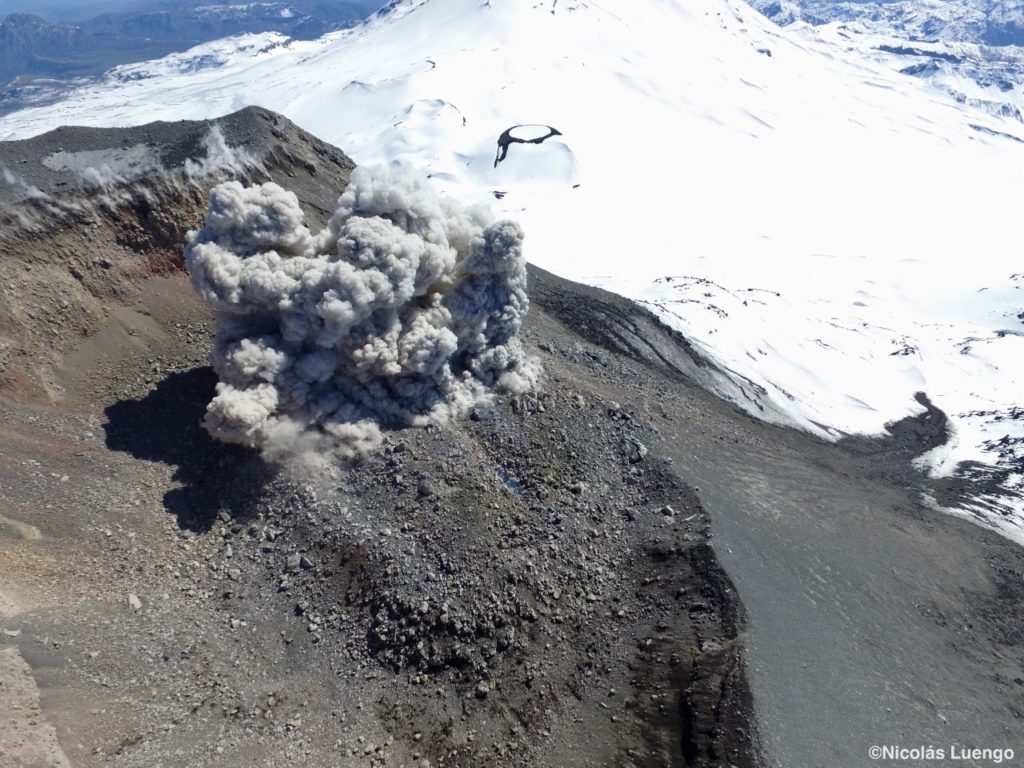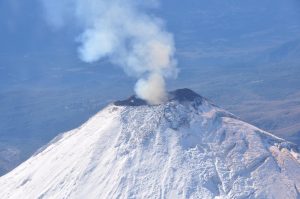October 31 , 2019.
Italy , Stromboli :
Daily Bulletin of 30/10/2019
SUMMARY OF ACTIVITY STATUS
In light of the surveillance data, we highlight:
1) VOLCANOLOGICAL OBSERVATIONS: Normal explosive activity of Strombolian type accompanied by degassing activities.
2) SISMOLOGY: The level of volcanic tremor generally shows medium-high values with some oscillations on high values. The magnitude of the earthquakes of explosions remained between average / low and medium / high with some events of high amplitude. Please note the occurrence of rare hybrid events.
3) DEFORMATIONS: The deformation monitoring networks of the island did not show any significant variation in communication during the last 24 hours.
4) GEOCHEMISTRY: The flow of SO2 is at an average level. There is no measure of CO2 / SO2 ratio available. The last value for the day of 27/10/2019 was at low levels. The isotopic ratios of helium dissolved in the thermal layer remain unchanged for the mean-low values (data of 23/10/2019).
VOLCANOLOGICAL OBSERVATIONS.
The analysis of the images of surveillance cameras at 400 m altitude (SQV and SQT) and Punta dei Corvi (SCPT), updated at 09:00 UTC on 30/10/2019, highlighted an ordinary Strombolian activity with the most active mouths in the North and South-Central craters. The total daily time frequency was 22 events / h (high frequency). In detail in the North zone, the explosive activity was 7 to 8 events / h of low intensity (less than 80 m high) and medium (less than 150 m high) explosions emitting coarse materials (lapilli and bombs) that sometimes covered the slopes of the cone facing the Sciara del Fuoco. In the Center-South zone, an average explosion frequency of 15 to 16 events / h (ash mixed with coarse material) of medium intensity (less than 150 m in height) and sporadically high (the products reached 250 m ) has been observed. The raw products also fell in the direction of the Sciara del Fuoco.
The level of volcanic tremort remained at medium to high values, with peaks at high values.
Source : INGV.
Read the full article : file:///C:/Users/Utilisateur/AppData/Local/Packages/Microsoft.MicrosoftEdge_8wekyb3d8bbwe/TempState/Downloads/BollettinoGiornalieroStromboli20191030%20(1).pdf
Photo : Willie FotoDive
Chile , Nevados of Chillan :
Volcanological Special Report (REAV) Régie de Ñuble, Nevados de Chillán Volcanic Complex, October 29, 2019, 03:50 local time (mainland Chile)
The National Geological and Mining Service of Chile (Sernageomin) discloses the following PRELIMINARY information obtained from the monitoring equipment of the National Volcanic Monitoring Network (NVRN) processed and analyzed at the Volcanological Observatory of the Southern Andes ( OVDAS)
On Tuesday, October 29 at 3:27 am local time (06h27 UTC), the control stations installed near the Nevados Volcanic Complex of Chillán recorded a volcano-tectonic event of local magnitude 3.2.
The characteristics of the earthquake are as follows:
TIME OF ORIGIN: 03:27 local time (06:27 UTC)
LATITUDE: 36 883 ° S
LONGITUDE: 71.347 ° W
DEPTH: 4.07 km
LOCAL MAGNITUDE: 3.2.
OBSERVATIONS:
The volcanic technical alert is maintained at the level: ORANGE.
Other remarks:
– The network of GNSS stations installed on the volcanic complex recorded a maximum increase in the length of the control lines crossing the active crater of 3.8 ± 0.1 cm.
– The elongation rate of the last 30 days is 0.7 ± 0.06 cm / month. During this period, the lengthening continues in all monitoring stations. The vertical lift rate for the last 30 days is 1.4 ± 0.3 cm / month, at the closest station to the active crater (1.5 km).
– The MIROVA group did not report any thermal anomalies.
– Infrasound sensors recorded explosion-related signals (EX), with peak values of 27.2 Pa reduced to 1 km.
Sernageomin monitors online and informs in a timely manner of possible changes in volcanic activity.
Source : Sernageomin.
Photo : Nicolas Luengo.
Mexico , Popocatepetl :
October 30, 11:00 am (October 30, 17:00 GMT)
According to the monitoring systems of the Popocatepetl volcano, 267 exhalations have been identified. Due to the nebulosity of the area, there was no visibility for most of the period covered by this report; it has sometimes been verified that they are accompanied by steam and gas. Similarly, 188 minutes of tremor have been identified.
At the time of writing, there was no visibility due to weather conditions. However, it was possible in previous hours to distinguish an emission of water vapor and volcanic gas dispersing in the direction of the Southwest.
CENAPRED urges NOT to approach the volcano and in particular the crater because of the risk of falling ballistic fragments, and in case of heavy rains to stay away from the bottom of the ravines due to the risk of mudslides and debris.
The warning light of Popocatépetl is in YELLOW PHASE 2.
Source : Cenapred.
Photo : Archives webcam
Alaska , Semisopochnoi :
51°55’44 » N 179°35’52 » E,
Summit Elevation 2625 ft (800 m)
Current Volcano Alert Level: ADVISORY
Current Aviation Color Code: YELLOW
Semisopochnoi, view of Anvil Peak from the southwest. Image courtesy of Ian L. Jones, Department of Biology, Memorial University.
Seismic activity has increased at Semisopochnoi over the past day with continuous tremor observed on local seismic stations beginning this morning. No eruptive activity has been detected by regional infrasound data, and no anomalous activity was observed in satellite data in the past 24 hours.
Semisopochnoi is monitored with an on-island seismic network and remotely by satellite and lightning sensors. An infrasound array on Adak Island may detect explosive emissions from Semisopochnoi with a slight delay (approximately 13 minutes) if atmospheric conditions permit.
Source : AVO.
Photo : Jones, I. L. 30 Juin 2004.








